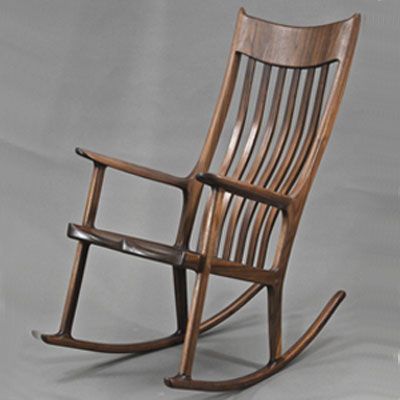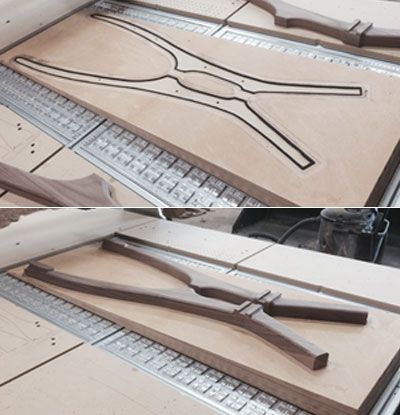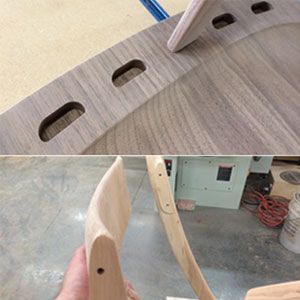
Raised by a craftsman who taught others about woodworking, it was almost guaranteed that Russell Crawford would inherit this passion for woodwork from his father. Between running a dental practice, tending to his animals within his many acres of land and of course spending time with his family somehow Russell still finds time to run his CNC machine and create some fine projects. Russell first learnt his skills in his father’s workshop, but now has the privilege of his own – but it wasn’t easy to get the go-ahead…
The secret to getting permission to build a shop is to fill your garage with tools, forcing your wife to park outside in the cold Alberta winters! My father taught woodworking for 35 years, so I was basically raised in a wood shop. For years, I would travel home to work in his shop, building furniture using traditional methods and tools. When I finally graduated from university and bought my own home, it didn’t take long for my garage to fill up; a Unisaw came first, then a jointer and planer, thickness sander, bandsaw, workbench, etc. When my wife’s car was forced out into the snow, I got permission to build my own shop!
I started building furniture as a way to earn extra money during my university years. Maloof style rocking chairs were my staple; I was able to prepare and cut the parts and joints in my father’s shop, and then assemble, carve, shape, and complete the finishing at my own place. The rocking chairs evolved into dining chairs and stools, using the same joinery and carved seats. While extremely time consuming, it was very rewarding work.
There is never enough time to accomplish all I desire in a day. I have a growing family, a busy dental practice, and hundreds of acres of land with animals to maintain. It became apparent that I could not accomplish all I wanted in woodworking while using traditional tools and techniques, so I started looking into CNC technology. This was a tough decision for me, as CNC carries a definite stigma among traditional woodworkers. But, while bandsaws, gouges, and patternmaker’s rasps are great tools to work with, the exhaustive amount of time required to produce one piece of furniture becomes prohibitive. I wasn’t getting anywhere taking 80 hours to produce one rocking chair!
My first venture into the CNC world was with a Shark. This was a great learning tool, allowing me to get my feet wet, learn the design software, and get a feel for the hardware. However, it didn’t take long to realize that I needed a heavier, sturdier, and faster machine to build furniture with. After a lot of research, I eventually ended up with a Cobra 408 ATC from CAMaster. Great machine, great company to work with, and a strong forum to interact with other owners.
My biggest challenge has been converting traditional designs to digital models, and eventually into toolpaths for my Cobra. Aspire has been an essential tool in this process. 95 percent of my design work is done in Aspire, with some of the more complex 3D work (especially around the stool legs joints) being done with Rhino and then imported into Aspire for toolpathing. Wherever possible I use 2D toolpaths with profile bits in order to save time and achieve a better finish.
The rocking chair was definitely the most complex design work of all my furniture, and was accomplished entirely in Aspire. The rockers are laminated from eight strips of 6/4 stock, using an MDF form cut on the Cobra. The perfectly formed curves are essential for a smooth rocker action.
The armrests were the most difficult part to design, and took countless prototypes before I achieved the results I needed. These are cut using two sides machining, with 3/8” dowels used to index the blanks when they are flipped.
The next challenge was the back legs. They have a 5 degree taper outwards towards the headrest, making the design quite complex as the joint itself does not have any taper. I was able to cut these using a tapered vacuum jig, and then round over the back of the leg at the router table once the front was machined on the jig. I use several different vacuum jigs, and all of them index on an aluminum plenum that is permanently mounted to my Cobra bed.
The seat is cut using 2 sided machining (for the joints), with mortises cut for the back slats. The back slats are cut from a single piece of 6/4 stock. The front profile is cut on the slab, then the piece is roughly bandsawn from the slab and placed on a jig to cut the back profile. The edge roundover is done on a router table.
The head rest is cut using 3 sided machining, with mortises cut into the bottom for the back slats.
Preparing the blanks, cutting the parts on the CNC, sanding, assembly, and then final sanding and finishing takes less than 20 hours. That means I can produce 4 rockers with Aspire and my Cobra in the same amount of time it takes me to produce one rocker using traditional methods. And I get perfectly symmetrical and predictable results, every time!
I am currently spending 15-20 hours a week working in my shop or working on designs. I am constantly looking for ways to reduce the time it takes to make my furniture, while keeping the quality as high as possible. I do a lot of prototyping, setting up jigs and perfecting my files so that someday, hopefully soon, I can transition to woodworking full time!
We would like to thank Russell for taking the time out of his (incredibly) busy schedule to share his story with us and also to showcase his craftsmanship. We feel suitably inspired to find a way to fit more time into our busy schedules to work on our own projects! If you would like to see more of Russell’s excellent work please visit his website: www.cherryleaf-rustle.com







Vectric Ltd
Precision House
2 Arden Road
Alcester
B49 6HN
Registered in England Number 05382596
VAT Registration GB115123072
Privacy Policy |
Cookie Policy |
Terms and Conditions